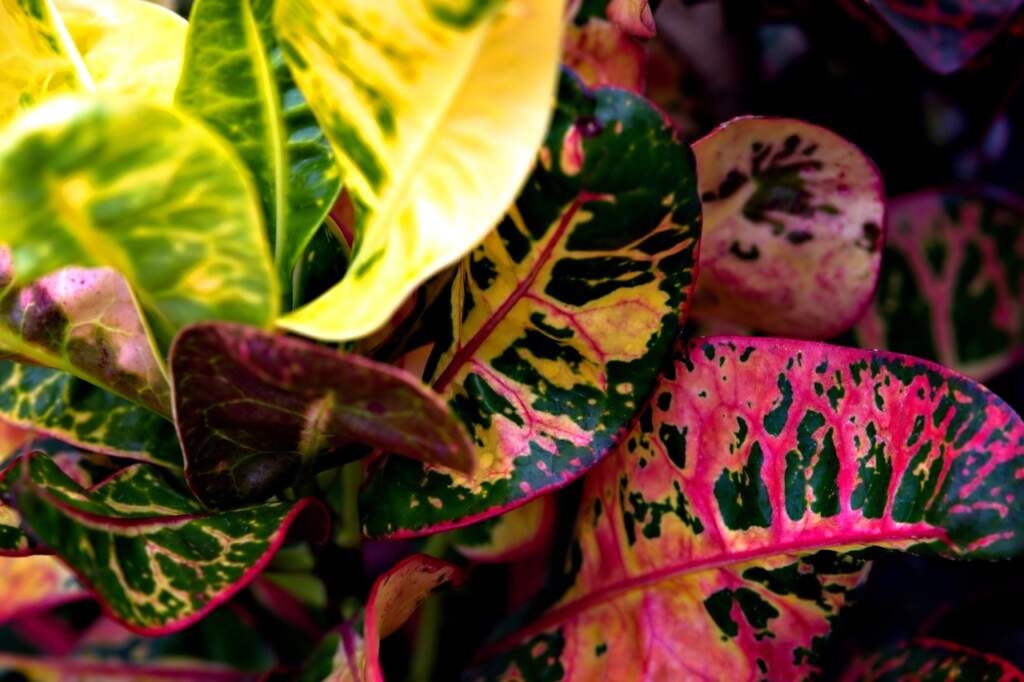
Croton plants, scientifically known as Codiaeum variegatum, are renowned for their vibrant foliage, making them a popular choice for indoor plant enthusiasts and landscapers alike. Originating from tropical regions of Asia and the Pacific Islands, these evergreen perennials belong to the Euphorbiaceae family, which also includes the poinsettia.
One of the most striking features of croton plants is their colorful leaves. They come in a wide range of colors, including red, yellow, green, orange, cream, pink, and purple, often combined in spectacular variegated patterns. This color variation is not just for show; it’s a result of light exposure. The more light a croton plant receives, the more vibrant its leaves become. This characteristic makes them an excellent choice for adding a splash of color to any space.
Croton plants can vary significantly in appearance, not just in color but also in leaf shape and size. Some common varieties include the ‘Petra,’ known for its broad, bright green leaves with bold yellow, red, or orange veining, and the ‘Gold Dust’ variety, which features smaller green leaves speckled with yellow. Other popular varieties include ‘Mammy,’ ‘Red Iceton,’ and ‘Zanzibar,’ each with its unique leaf patterns and colors.
Click here to learn about the many varieties of Codiaeum.
Light Requirements
Crotons need a lot of light to maintain their vibrant colors. Ideally, they should be placed in a location where they can receive at least 6-8 hours of bright, indirect sunlight daily. An east or west-facing window is usually ideal. Direct sunlight can scorch the leaves, whereas insufficient light can cause the leaves to become more green and lose their variegation. If you’re growing crotons indoors in a relatively darker space, consider using grow lights to supplement their light needs.
Watering
Watering is crucial in the care of crotons. The soil should be consistently moist but not waterlogged. Over-watering can lead to root rot, a common problem in crotons. Conversely, under-watering can cause the leaves to wilt and fall off. Water the plant when the top inch of the soil feels dry to the touch. Reduce watering in the winter months when the plant’s growth naturally slows down.
Humidity and Temperature
Crotons thrive in a humid environment, typical of their tropical origin. If your home is dry, especially in the winter, use a humidifier or place the plant on a tray filled with pebbles and water to increase humidity around it. They prefer temperatures between 60-85°F (15-29°C). Avoid placing your croton near cold drafts or heating vents, as they are sensitive to sudden temperature changes.
Soil and Repotting
Use a well-draining potting mix for crotons, preferably one that is rich in organic matter. A mix designed for tropical plants, or a combination of regular potting soil, peat, and perlite or sand, works well. Crotons need to be repotted every 1-2 years, typically in the spring. Choose a pot that is slightly larger than the current one to give the roots more room to grow. Ensure the new pot has adequate drainage holes.
Fertilizing
Feed your croton with a balanced, water-soluble fertilizer every 4-6 weeks during the growing season (spring and summer). Do not fertilize in the fall and winter when the plant’s growth naturally slows down. Over-fertilizing can damage the plant, so it’s important to follow the recommended dose on the fertilizer package.
Pruning
Pruning helps maintain the shape of the plant and encourages fuller growth. Prune in the spring or early summer by cutting back leggy growth, dead leaves, or branches. Always use clean, sharp scissors or pruners, and be cautious as the sap can be an irritant to the skin.
Common Pests and Problems
Crotons can be susceptible to common houseplant pests such as spider mites, mealybugs, and scale insects. Regularly inspect your plant for signs of pests and treat promptly with insecticidal soap or neem oil. Yellowing leaves can indicate over-watering, while drooping leaves usually signify under-watering or low humidity.
Propagation
Propagating crotons can be done through stem cuttings. Cut a 4-6 inch stem, remove the lower leaves, and allow the cutting to dry for a few hours to form a callus over the cut surface. Dip the cut end in rooting hormone and plant in a well-draining soil mix. Keep the soil moist and place the pot in a warm, bright location until roots develop.
Toxicity
Crotons are toxic to pets and humans if ingested. The sap can also cause skin irritation. Keep them out of reach of children and pets.
Special Considerations
- Acclimatization: When you first bring a croton home, it may drop some leaves as it adjusts to its new environment. This is normal, and with proper care, the plant will acclimate and grow new foliage.
- Seasonal Changes: Expect some leaf drop in winter due to lower light levels and humidity.
- Leaf Shine: Avoid using leaf shine products as they can clog the pores of the leaves.
Conclusion
Croton plants require a bit of extra care and attention, but their stunning foliage is a worthy reward. By providing them with the right amount of light, water, and humidity, and by being mindful of their temperature and soil needs, you can enjoy the vibrant beauty of these tropical plants in your home or office. Regular care, along with being vigilant about pests and diseases, will keep your crotons healthy and thriving. With patience and attention to their specific needs, these striking plants can be a long-lasting and colorful addition to your plant collection.


